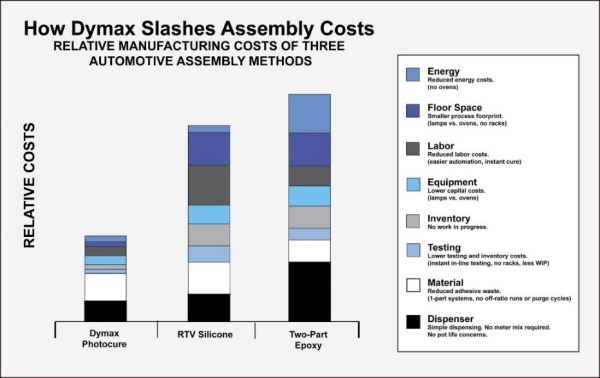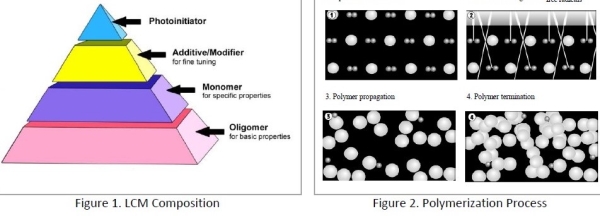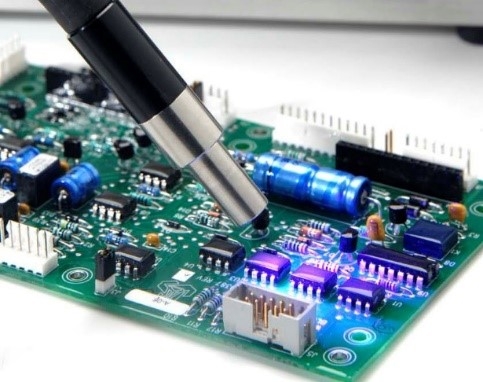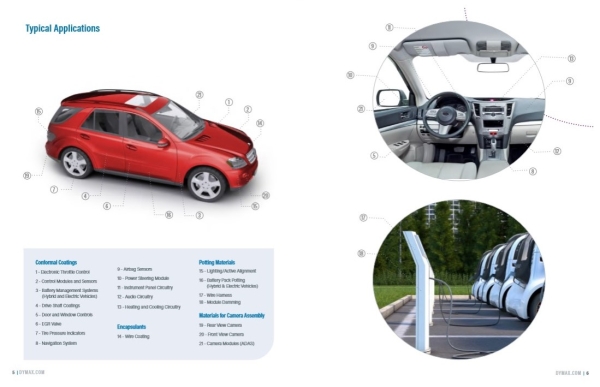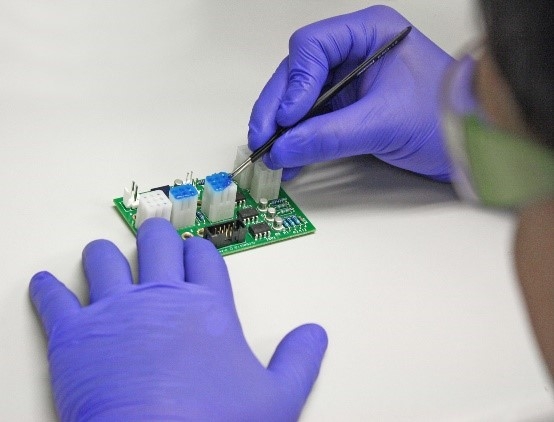Avances en la electrónica de vehículos eléctricos con tecnología de curado por luz
Se prevé que el mercado mundial de la electrónica automotriz crezca a una CAGR cercana al 6-7% durante los próximos cinco años, con los segmentos de electrificación y sistemas avanzados de asistencia al conductor (SAAC) posicionados para aumentar al 16%. Este crecimiento sin precedentes, junto con mayores regulaciones ambientales y requisitos de seguridad, y el deseo del consumidor de mayores comodidades en el vehículo, ha hecho que los fabricantes de vehículos busquen formas de mejorar el rendimiento del sistema y al mismo tiempo reducir los costos generales. Los materiales tradicionales a base de solventes y los sujetadores mecánicos pueden ser menos costosos de comprar e implementar, pero a largo plazo, aumentan los costos generales de fabricación. Como resultado, muchos ingenieros de diseño de vehículos eléctricos, vehículos eléctricos de batería y vehículos eléctricos híbridos enchufables están recurriendo a la tecnología de curado por luz para resolver problemas relacionados con el bajo rendimiento, la difícil eliminación de desechos y las fallas en el campo.
"Los cambios legislativos, los artículos demandados por los consumidores (en particular los relacionados con la comodidad y/o conveniencia), así como las mejoras en la seguridad, han impulsado el desarrollo automotriz año tras año. Hoy, con la popularidad adicional de la electrificación y la conducción autónoma, el volumen de electrónica en los vehículos está creciendo rápidamente, incluso a medida que la demanda de vehículos se modera. Estos impulsos, combinados con una mayor necesidad de emisiones más limpias y una mejor economía de combustible, también están aumentando la necesidad de materiales que respeten el medio ambiente", Chris Morrissey, gerente sénior de electrónica automotriz de Dymax.
Tres segmentos del mercado que impulsan el aumento del uso de tecnologías de fotopolimerización en el diseño de la electrónica de los vehículos eléctricos son los sistemas SAAC, de infoentretenimiento y de gestión de baterías (BMS). Existe la necesidad de materiales que resuelvan problemas comunes asociados con los sensores, módulos y circuitos que se encuentran en los módulos de cámara, lidar, placas de circuitos impresos y baterías de vehículos eléctricos. Además, es cada vez más importante sustituir las tecnologías que contienen ingredientes peligrosos, producen residuos y requieren mayores cantidades de energía para su procesamiento. También existe el deseo de aumentar la funcionalidad, reducir el tamaño de los circuitos y ampliar las garantías.
Hace 40 años, Dymax fue fundamental en el desarrollo de los materiales curables por luz (MATERIALES DE CURADO CON LUZ) tal como los conocemos hoy. Gracias al ingenio y la visión de futuro del fundador de la empresa, Andrew G. Bachmann, se creó una química que era respetuosa con el medio ambiente y que aumentaría significativamente la productividad en los procesos de fabricación industrial. Los MATERIALES DE CURADO CON LUZ pueden proporcionar importantes ventajas en comparación con las tecnologías de pegado (o pegado) convencionales, como menores costes operativos gracias a menores necesidades de mano de obra, ahorro de espacio, menor demanda de energía y mayor rendimiento.
¿Cómo funcionan los materiales curables con luz?
Los materiales curables con luz suelen estar compuestos por cinco elementos básicos: el fotoiniciador, el aditivo, el modificador, el monómero y el oligómero (Figura 1). El proceso de curado con luz ultravioleta (UV) comienza cuando el fotoiniciador del LCM se expone a una fuente de energía luminosa con la salida espectral adecuada. Como se ilustra en la Figura 2, las moléculas del LCM se dividen en radicales libres (iniciación), que luego comienzan a formar cadenas de polímeros con los monómeros, oligómeros y otros ingredientes (propagación), hasta que todos los ingredientes han formado un polímero sólido (terminación). Tras una exposición suficiente a la luz, el LCM líquido se polimeriza o cura en cuestión de segundos.
Los tipos de materiales curables por luz que se utilizan con éxito en todo el mercado de la electrónica de vehículos eléctricos incluyen adhesivos estructurales, recubrimientos electrónicos, encapsulantes y resinas de enmascarado . Desde su creación, los MATERIALES DE CURADO CON LUZ de Dymax han ayudado a minimizar el impacto ambiental. Los productos formulados son todos de un solo componente, libre de solvente, sin halógenos, cumplen con la normativa RoHS, son ecológicos y cumplen con los requisitos de REACH (no se permiten sustancias altamente preocupantes [SVHC]). El uso de estos productos ofrece a los fabricantes muchos beneficios:
• Mejora de los enlaces estructurales
• Protección de circuitos contra daños ambientales.
• Minimizar el movimiento y la contracción.
• Abordar la gestión térmica, el choque térmico y la vibración.
• Mejora de la funcionalidad y el rendimiento de PWB/PCA
• Eliminación de preocupaciones sobre áreas de sombra
• Solución de problemas de confirmación de curación
Adhesivos
Los adhesivos curables se curan en segundos tras la exposición a la luz visible/UV. Forman uniones de alta resistencia y resistentes al medio ambiente con sustratos de plástico, metal y vidrio utilizados en la fabricación de componentes electrónicos automotriz . Debido a su capacidad para unirse a una amplia variedad de sustratos, son excelentes para ensamblar materiales diferentes, algo que no se puede hacer con los métodos de fijación tradicionales y otras sustancias químicas. El curado rápido de los adhesivos es una de las principales ventajas que tienen los MATERIALES DE CURADO CON LUZ sobre otros procesos de aplicación de curado lento y que requieren mucha mano de obra.
Recubrimientos electrónicos
Los recubrimientos electrónicos mejoran la confiabilidad a largo plazo de las piezas electrónicas de los automotriz . Cuando se aplican a los circuitos de las placas de circuitos impresos, actúan como protección contra condiciones ambientales destructivas que, si se dejan sin recubrimiento (sin protección), podrían provocar una falla total de los sistemas electrónicos. Una ventaja clave de los recubrimientos electrónicos curables con luz es la capacidad de utilizar un material "ecológico" no solvatado (100 % sólidos). Otras propiedades importantes del material incluyen la resistencia a cambios rápidos y extremos de temperatura, así como la protección contra altas temperaturas, humedad, productos químicos como la gasolina y materiales corrosivos como la sal y el azufre.
Encapsulantes
Los materiales de encapsulación y pegado por cable para chips desnudos, uniones por cable o circuitos integrados (IC) que se encuentran en las PCB presentan una excelente protección contra choques térmicos, calor, humedad y diversos elementos corrosivos. Su curado rápido ayuda a reducir los costos de procesamiento y energía asociados con las tecnologías alternativas.
Resinas de enmascarado
Los enmascarantes electrónicos temporales y despegables se aplican a los componentes de las placas de circuitos impresos para protegerlos antes de la aplicación del recubrimiento conformado o de los procesos de soldadura por ola y reflujo. El curado extremadamente rápido permite que las placas se procesen inmediatamente sin necesidad de bastidores o esperas. Los productos se adaptan a diseños intrincados, no se desploman en superficies verticales y horizontales, son compatibles con pines de conectores de oro y cobre y son resistentes a los recubrimientos electrónicos y las imprimaciones a base de solventes. Después del curado adecuado, los enmascarantes no dejan silicón, contaminación iónica ni residuos corrosivos cuando se eliminan.
Aplicaciones de electrónica para vehículos eléctricos en las que se utilizan MATERIALES DE CURADO CON LUZ de Dymax
Hay una serie de tecnologías formuladas en varias químicas LCM de Dymax para mejorar la fabricación general de la electrónica de los vehículos eléctricos.
Curado en áreas de sombra
Tecnología de curado dual por luz y humedad
Los recubrimientos de curado dual están formulados para garantizar un curado completo en aplicaciones donde las áreas de sombra en placas de circuitos de alta densidad son un problema. Anteriormente, las áreas sombreadas por la luz se manejaban con un recubrimiento selectivo, lo que eliminaba la necesidad de curar en áreas de sombra , o un proceso secundario de curado por calor. Las áreas de sombra se curan con el tiempo con la humedad, lo que elimina la necesidad de ese segundo paso del proceso o las preocupaciones por la degradación de la vida útil del componente debido a la exposición a la temperatura.
Curación múltiple ® Tecnología de curado por luz/calor
Los adhesivos y recubrimientos Multi-Cure combinan el curado de alta velocidad de la luz visible/UV con mecanismos de curado secundario que mejoran la polimerización. Los mecanismos de curado secundario, que incluyen el curado por humedad, térmico o activador, son útiles cuando la luz solo puede alcanzar una parte de la línea de unión o cuando se fija una pieza antes del curado final para permitir una manipulación y transporte más fáciles durante el proceso de fabricación.
Mejorar la inspección de la línea de unión
Tecnología de fluorescencia azul
Muchos materiales curables con luz cuentan con tecnologías que permiten una fácil confirmación visual del curado y una inspección posterior al curado. En la fabricación a alta velocidad, se emplean sistemas de visión automatizados para inspeccionar las piezas terminadas en busca de imperfecciones en la línea de unión o para detectar una cobertura de recubrimiento incompleta. Las formulaciones con tecnología de fluorescencia azul son visibles bajo luz negra de baja intensidad para una fácil confirmación visual de piezas terminadas correctamente.
Materiales de colores brillantes
Algunos MATERIALES DE CURADO CON LUZ contienen un pigmento de color, como rosa o azul, en estado no curado, que permite verlos fácilmente cuando se aplican sobre sustratos para garantizar una cobertura completa del material. Una vez expuestos a la cantidad adecuada de energía de luz visible/UV , el color cambia a otro color o se vuelve incoloro, lo que confirma el curado completo.
Acelere la producción con Environment Curado ambientalmente amigable
Tecnología de curado por luz LED
Debido a los costos y la dificultad asociados con la eliminación de desechos peligrosos, los fabricantes están comenzando a implementar materiales curables con LED y fotocurado en sus procesos. El curado con LED se considera una tecnología "verde" porque ofrece a los fabricantes los siguientes beneficios:
• Alta eficiencia eléctrica y capacidad de encendido y apagado instantáneo para menores costos operativos.
• Larga vida útil que elimina la necesidad de reemplazar bombillas y reduce los costos de mantenimiento.
• Equipo compacto que reduce el tamaño y el costo del sistema de fotopolimerización.
• La radiación de luz fría amplía las capacidades de curado de los sustratos sensibles al calor.
• Los atributos “verdes” eliminan los riesgos de seguridad y los costos de manipulación del mercurio y el ozono.
• La emisión de espectro de longitud de onda estrecha minimiza el aumento térmico del sustrato.
SAAC - Alineación activa (CMOS) y lidar (adhesivos, encapsulantes)
Los adhesivos y encapsulantes Dymax se utilizan para una variedad de aplicaciones de módulos de cámara y lidar, que incluyen la fijación de módulos de cámara, lentes a carcasa, fijación de lentes, pegado de filtros IR, carcasa a sustrato, pegado de matriz, unión de parabrisas y sensor de imagen a sustrato. Un aspecto fundamental para la fabricación de módulos de cámara para SAAC es el posicionamiento y el enclavamiento de las lentes dentro de la carcasa del módulo de cámara. La industria se está alejando de la alineación pasiva (es decir, fijación mecánica con clips) que puede hacer que la lente se mueva, se incline, se desenfoque y gire. La alineación activa con adhesivos curables con luz permite una fijación rápida (en segundos) para una alta precisión (<0,1 mm) y una alineación multieje con control óptico. Además, dado que la polimerización no ocurre hasta la exposición a la energía de la luz, las piezas ensambladas se pueden mover hasta que estén correctamente posicionadas. Después del posicionamiento, se utilizan encapsulantes para la protección ambiental de los componentes. Los adhesivos Dymax CMOS también cuentan con:
• Almacenamiento en frío, así como almacenamiento a temperatura ambiente.
• Baja contracción
• Capacidad de curado por LED y/o calor.
• Resistencia a la humedad y al ciclo térmico.
Otros beneficios que estos materiales aportan al proceso de ensamblaje incluyen acrilato de uretano y tecnologías de curado por calor y/o UV catiónico, formulaciones curables con LED, muy baja resistencia al movimiento, al calor y a la humedad (85 °C, 85 % de humedad relativa) y excelentes adherencias al metal y a los plásticos.
Infoentretenimiento (basado en TARJETA DE CIRCUITO IMPRESO ) (recubrimientos electrónicos, encapsulantes, enmascarantes)
Una consideración clave para los ingenieros que buscan emplear tecnología de curado por luz en sus diseños de TARJETA DE CIRCUITO IMPRESO es si las placas cuentan o no con componentes de alto perfil que proyectan áreas de sombra donde la luz no puede llegar. Los recubrimientos electrónicos 100% sólidos de nueva formulación cuentan con un curado por humedad secundario que permite que el material debajo de las áreas de sombra se cure, lo que ayuda a eliminar las preocupaciones sobre el material sin curar en la TARJETA DE CIRCUITO IMPRESO. Estos productos muestran una alta confiabilidad en pruebas como resistencia al calor y la humedad (85 °C, 85 % de humedad relativa), resistencia al choque térmico (de -55 °C a +125 °C) y resistencia a la corrosión (flores de azufre, aerosol |pulverizador|rociado salina y fluidos automotriz comunes). Los recubrimientos electrónicos de curado dual de Dymax permiten el diseño de PCB más pequeñas y densas al permitir espacios más cortos entre conductores, mayor soporte mecánico para los componentes y una mejor vida útil por fatiga de las juntas de soldadura.
Los encapsulantes son materiales poliméricos que se utilizan para proteger el chip y la interconexión para garantizar la confiabilidad a largo plazo del ensamblaje del chip en la placa (COB). Los materiales Dymax se utilizan en aplicaciones de encapsulación líquida y glob top , donde se aplican sobre un chip y sus cables y luego se curan para formar una barrera protectora.
Los enmascarantes curables con luz son materiales temporales que se utilizan a nivel de placa para proteger las placas de circuitos impresos durante los procesos de acabado y ensamblaje de superficies.
Paquetes de baterías para vehículos eléctricos/BMS (recubrimientos electrónicos, encapsulantes, adhesivos)
El paquete de baterías de vehículos eléctricos incluye un sistema de gestión de baterías (BMS) para controlar el estado de carga, la temperatura, la corriente, equilibrar las celdas, determinar las condiciones de funcionamiento permitidas y enviar información al conductor. Las aplicaciones comunes de las baterías de vehículos eléctricos incluyen el encapsulado en vacío (potting) y la pegado por cable de los módulos de batería, la protección del recubrimiento de las PCB en el BMS, el sellado de las carcasas de las baterías y el encapsulado de electrodos en celdas unitarias. Se utiliza una variedad de MATERIALES DE CURADO CON LUZ para adherir y proteger estos componentes, incluidos los recubrimientos electrónicos para la gestión térmica y la protección exterior, los adhesivos estructurales para carcasas y marcos, y los encapsulantes para la pegado por cable. Los materiales Dymax se utilizan de manera más eficaz cuando la pegado y la fijación de celdas de baterías de iones de litio cilíndricas deben asegurarse dentro de celdas de carcasa de plástico y el recubrimiento de PCB.
A medida que evoluciona el mercado de la electrónica para vehículos eléctricos, Dymax seguirá desarrollando tecnología de curado por luz que haga que los fabricantes sean más capaces y eficientes.


